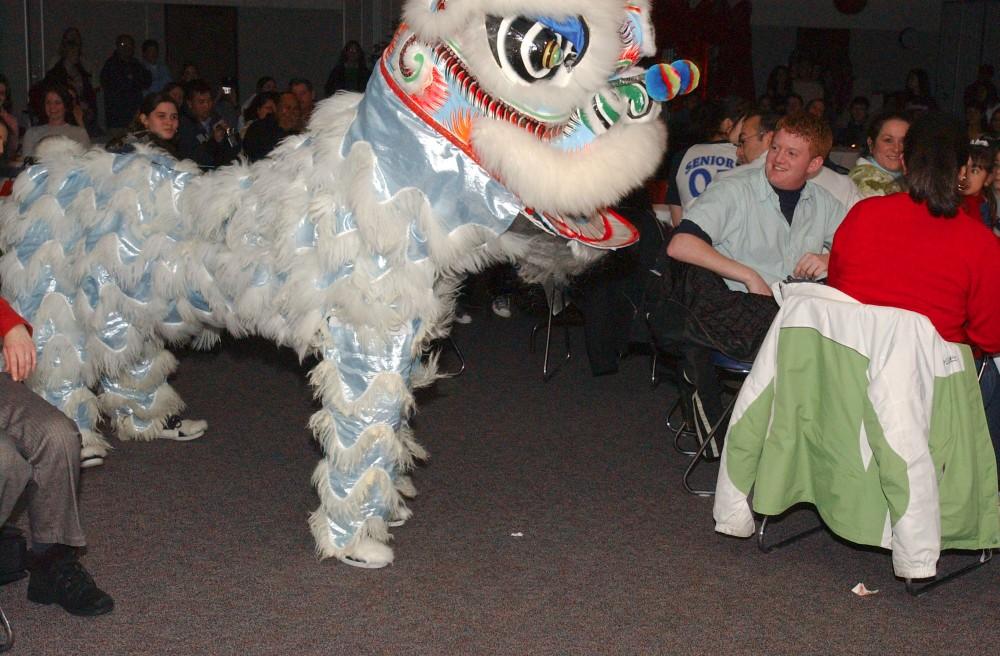GV celebrates Asian Pacific Islander heritage

GVL Archive A dragon makes an appearance during a past Pacific Asian Heritage Celebration
Jan 23, 2012
Grand Valley State University’s annual Asian Pacific American Islander Heritage Celebration begins this week with a discussion of Asian Pacific Islanders in Michigan and an Asian New Year celebration.
The annual event, which begins Wednesday and ends March 31, is organized by the GVSU Office of Multicultural Affairs. Documentary showings, an Asian New Year festival and speakers on various topics are among the events organized to commemorate different aspects of the many Asian cultures.
Danny Ha, program coordinator of the Office of Multicultural Affairs, said the official Asian-Pacific American Heritage month is actually May, but because most GVSU students are on break at the time, the university moved its celebration to January.
“We want to be inclusive of showing the Asian culture to all students,” Ha said. According to GVSU’s Office of Institutional Analysis, 752 students, or 3.2 percent, on campus identify as Asian or Pacific Islander. More than 1,000 students either declined to specify their ethnicity or checked multiethnic. Of the faculty on campus, 86 reported to be Asian or Pacific Islander.
Ha said the OMA found the end of January an appropriate time to begin honoring Asian cultures due to the Asian New Year celebrations.
Jerika Nguyen, an officer in the Asian Student Union, said the Asian New Year festival on Jan. 26 exposes traditions from different Asian cultures.
“In previous years, we have had various cultural and modern dance performances, a Tae Kwon Do demonstration, a traditional Chinese yo-yo performance, Lion Dancers and a fashion show,” Nguyen said. “This year, we have added Japanese Taiko drummers, a Bhangra dance group (and winners of a national talent competition), a Vietnamese Hat Dance, Dragon Dancers — and how apt for Year of the Dragon — and Asian Student Union’s first collaborative musical medley and dance performance.”
Ha said the focus of the entire heritage celebration changes from year to year.
“In years past it has been a mixture of different regions of Asia,” he said. “We showcase a lot of different cultures within Asia as a whole. This a great opportunity to see the vast diversity even within Asian culture, not just based on region but on tradition as well.”
Yan Liang, assistant professor of modern languages and literatures, said while Eastern culture still has yet to permeate American culture, it has been attracting attention from more and more Americans.
“It is something exotic, something interesting,” Liang said. “Still, there’s a long way to go before people have a true understanding of it.”
The Chinese professor said one of the biggest misconceptions Americans have about Asians is that all nations have the same cultural traditions.
“Each have their distinctive culture,” she said. “People tend to group (all Asian) people together. All the cultural symbols about Asia are together. It’s not accurate.”
Nguyen said many Asians confront this misunderstanding on GVSU’s campus.
“Some have no awareness of the distinction between various different Asian races and assume that they are all the same,” Nguyen said. “So if you’re Thai, you can probably speak Chinese, you were born in Korea, your parents fought in the Vietnam War and you own three Toyota Camrys. Oh, and your last name Yamamoto.”
However, Liang said Americans are not the worst at stereotyping Asians.
“I think in the U.S., it’s much better than many other parts of the world,” she said.
Liang added that East Asians are used to dealing with this misconception, but she said she hopes for a change someday.
“It would be really good if one day there would be enough sophistication and understanding of Asian culture that people could tell the difference,” she said.
Ha said the celebration hosted by OMA is meant to highlight both the differences and the similarities between Eastern and Western culture.
For a complete list of events, visit www.gvsu.edu/oma.
All events are free to the public.





















